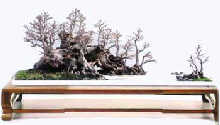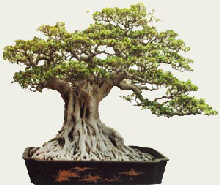 Potted landscape art, praised as "silent poetry", "stereoscopic paintings" or "living sculptures", is a rare and delightful Chinese art form. In a pot no larger than a washbasin, ingenious craftsmen create a miniature reproduction of a natural scene using stunted trees and plants, rocks and even water.
Potted landscape art, praised as "silent poetry", "stereoscopic paintings" or "living sculptures", is a rare and delightful Chinese art form. In a pot no larger than a washbasin, ingenious craftsmen create a miniature reproduction of a natural scene using stunted trees and plants, rocks and even water.
 History
History
It is very difficult to determine when potted landscapes first began, since the form was only considered a folk art in its initial stages. A mural in the tomb of Prince Li Xian of the earlyTang Dynasty(618-907) shows that the art form had already won royal favor at that time, although historical records suggest it can be dated much earlier than that -- nearly 4,000 years ago.
 Category
Category
 Potted landscapes, otherwise known as landscapes cultivated in pots, are made by putting the artistic touch on plants and stones arranged in a pot to make it look like an ornament -- a miniature of natural beauty. In general, potted landscapes fall into two categories: potted landscapes composed of plants (potted plants) and those made from stones and water.
Potted landscapes, otherwise known as landscapes cultivated in pots, are made by putting the artistic touch on plants and stones arranged in a pot to make it look like an ornament -- a miniature of natural beauty. In general, potted landscapes fall into two categories: potted landscapes composed of plants (potted plants) and those made from stones and water.
The potted plants are made from old, short stumps that can be easily maneuvered into a desired shape by hanging, binding, trimming, de-leafing and grafting. Some are made to look like moving beasts, some like soaring birds, and others like imaginary animals.
To make a potted landscape using stones and water, the stones must be carved, chemically altered and arranged in a dainty pan pot dotted with miniature pavilions, bridges, boats, plants and lichens. Using finest workmanship, the elements are arranged to conform to the laws of nature, reflecting the natural scenery with poetic charm: "Mountains extending hundreds of miles all are contained in a pot so small."